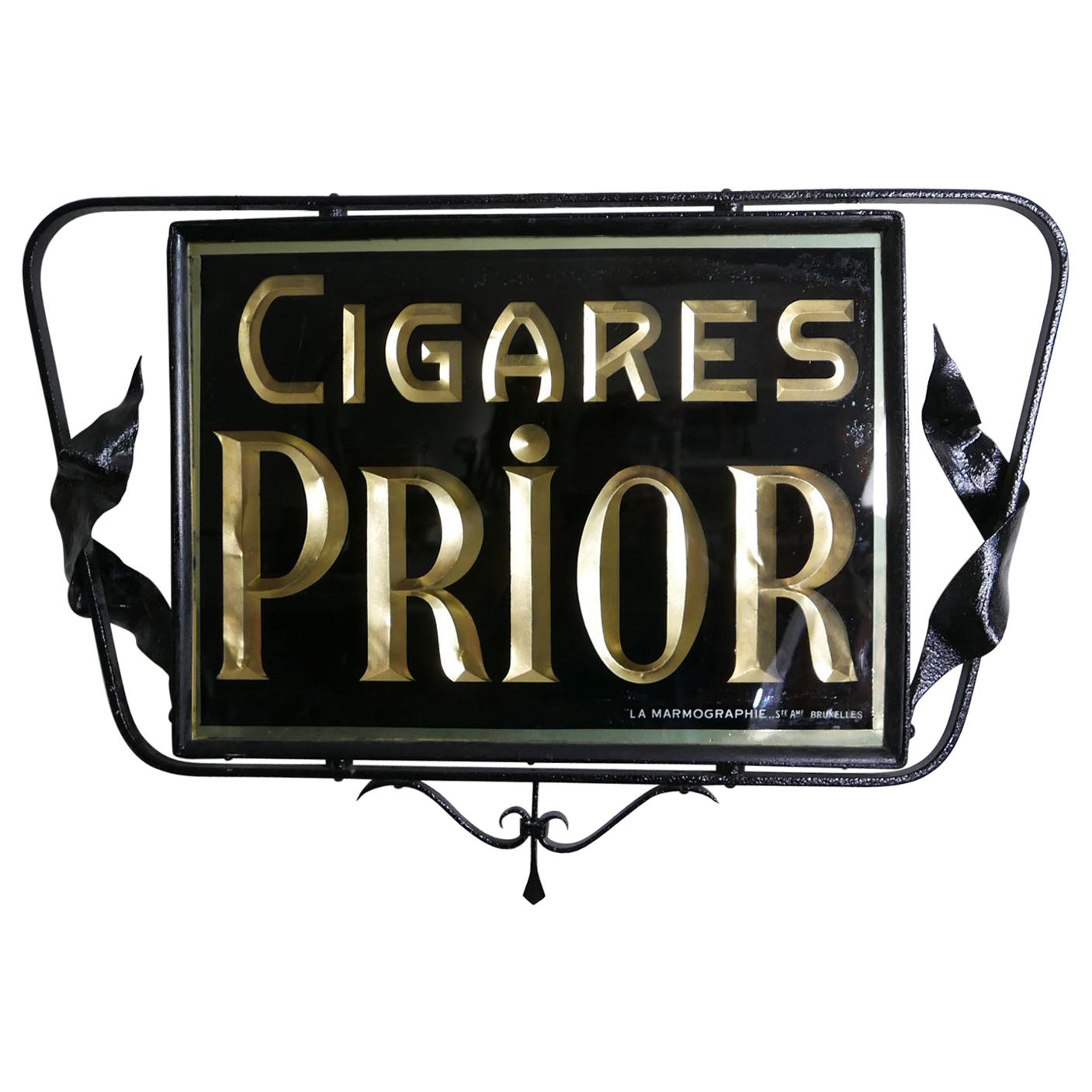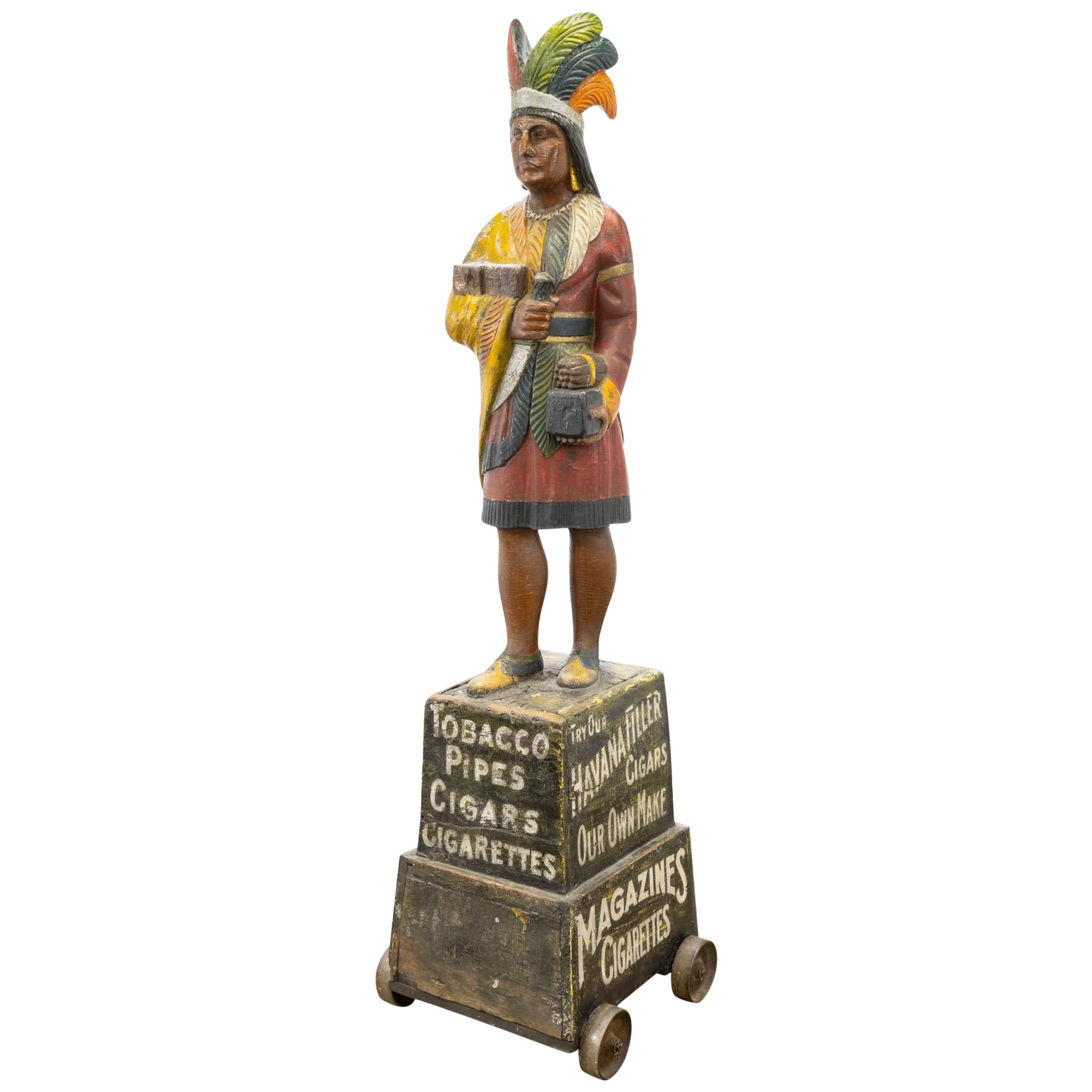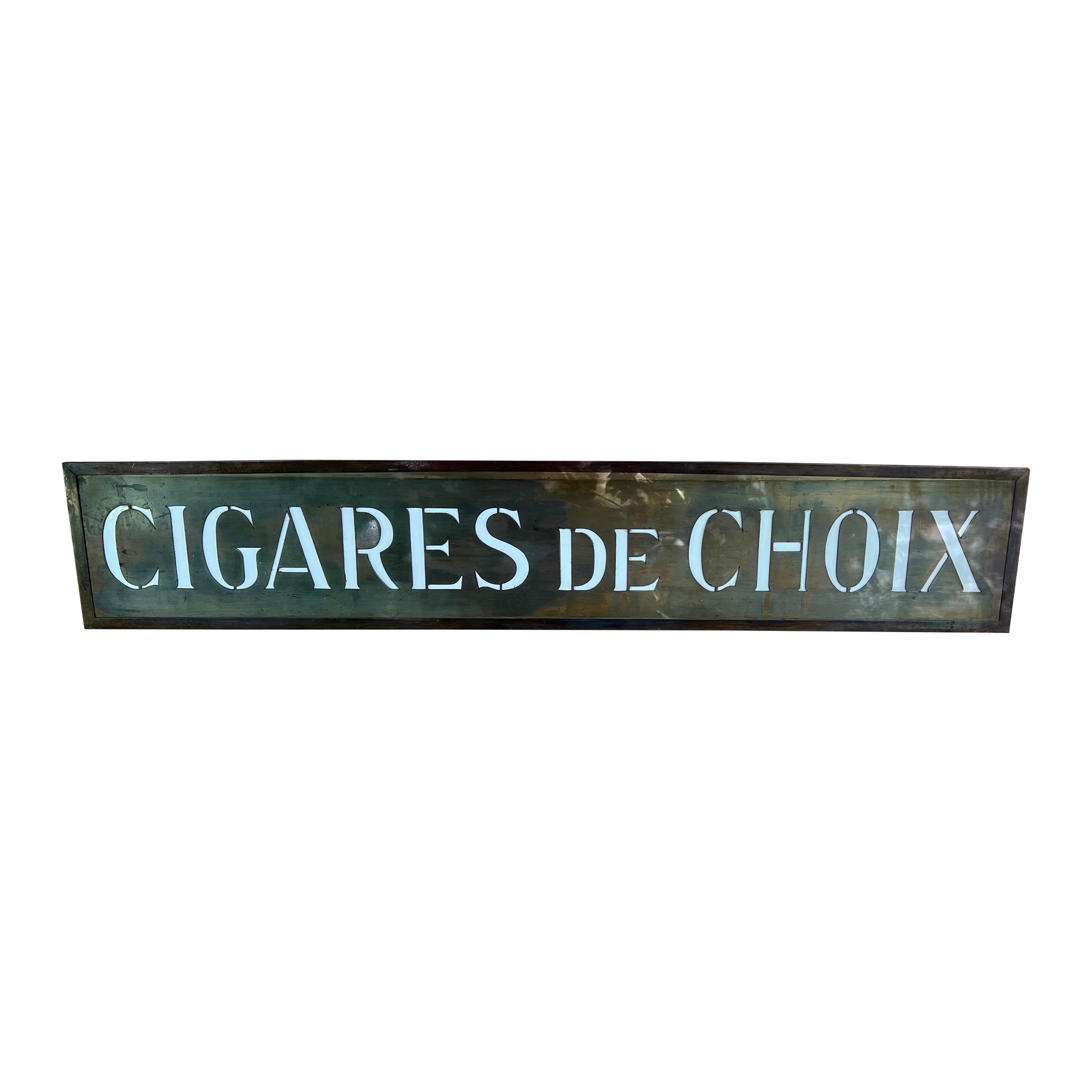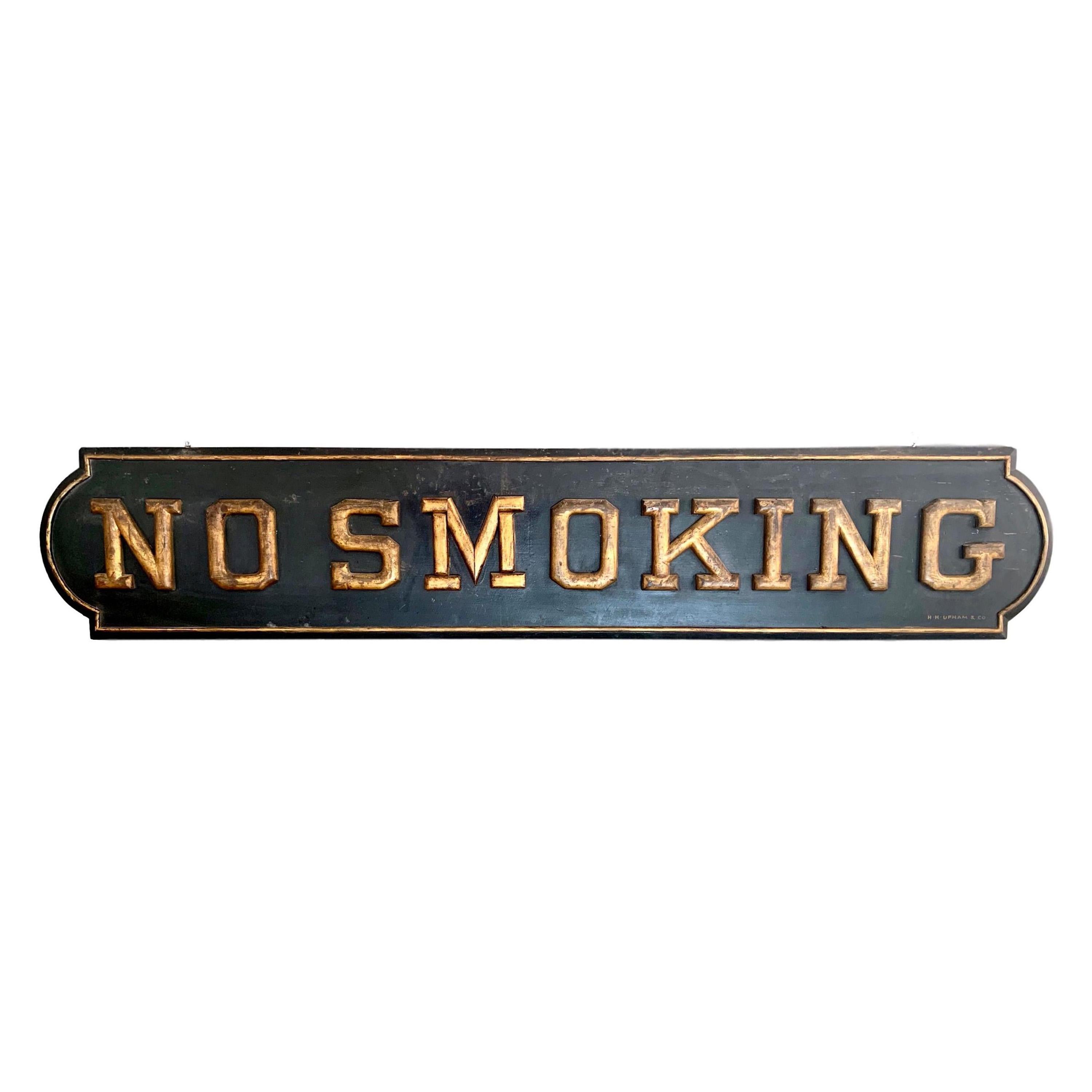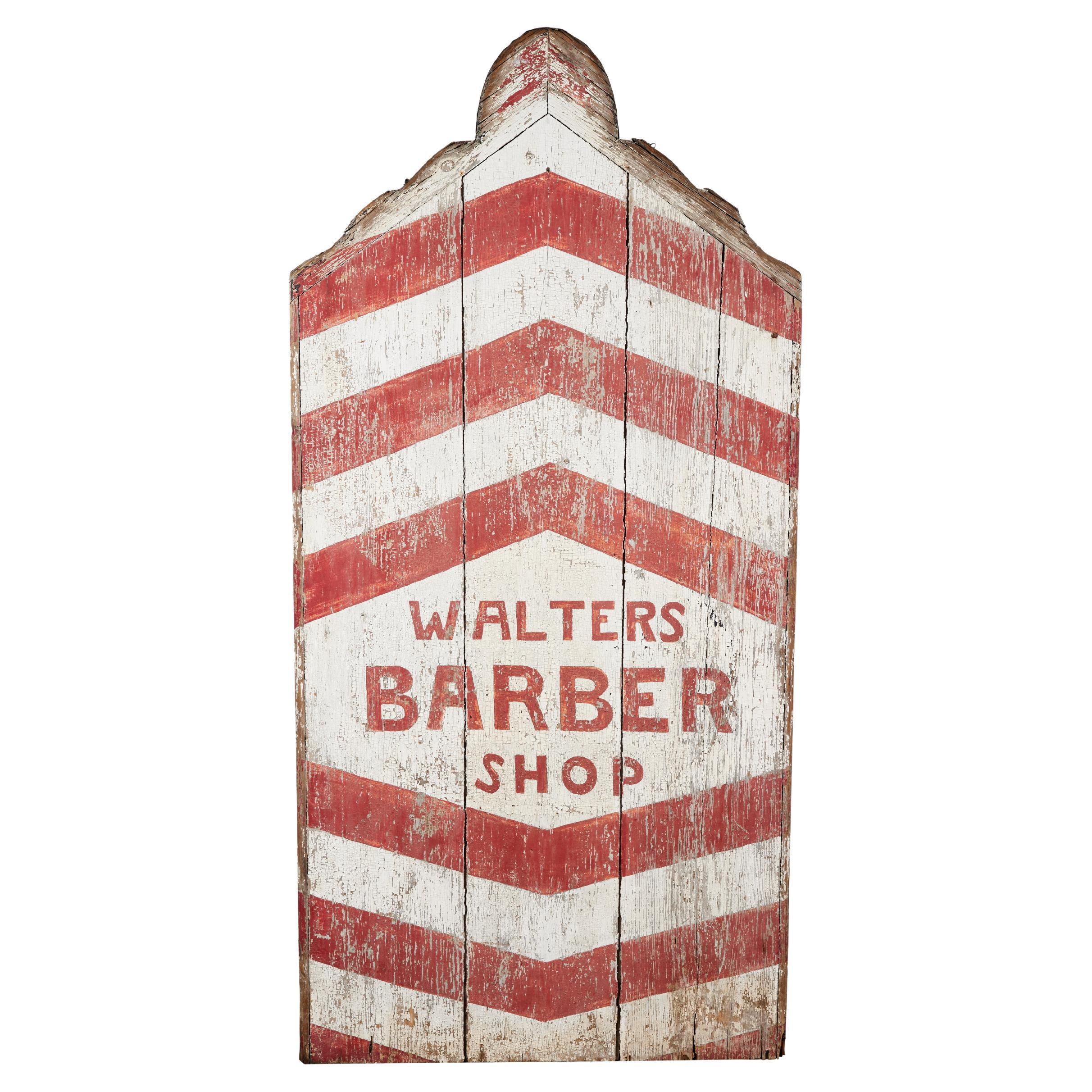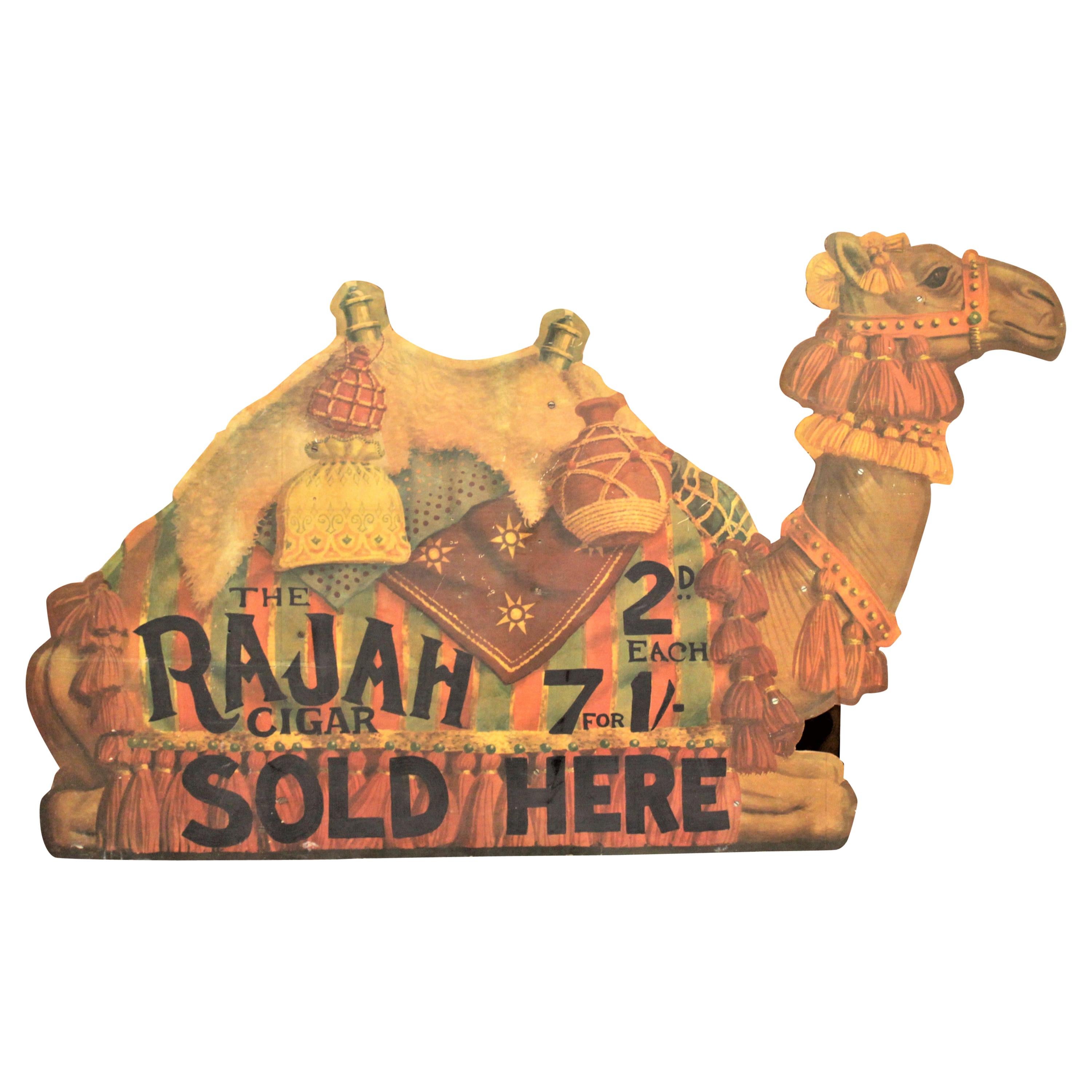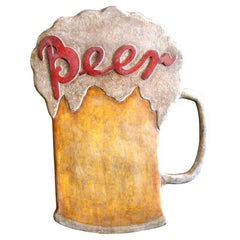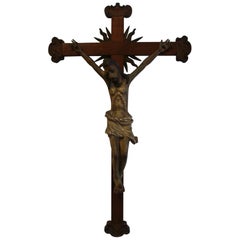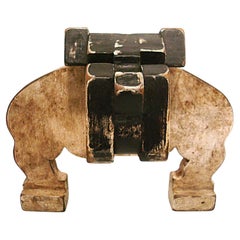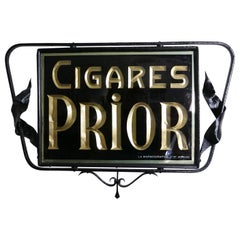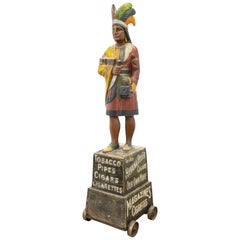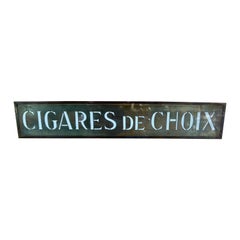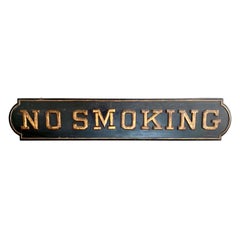Items Similar to Cigars Store / Trade Folk Art Wooden Carved Sign. c 1900
Want more images or videos?
Request additional images or videos from the seller
1 of 21
Cigars Store / Trade Folk Art Wooden Carved Sign. c 1900
$5,999
£4,555.18
€5,209.19
CA$8,381.47
A$9,322.03
CHF 4,867.67
MX$113,439.16
NOK 62,167.61
SEK 58,302.25
DKK 38,878.19
Shipping
Retrieving quote...The 1stDibs Promise:
Authenticity Guarantee,
Money-Back Guarantee,
24-Hour Cancellation
About the Item
American Folk art wooden "CIGARS" sign from the 1920's.
Great old Store Trade sign. Wood cut to cigar shape. Lettered in Gold Paint.
In good conditions, it was a in doors sign. Perfect for any cigar smoker.
Cigars History:
A cigar is basically dried tobacco leaves that are rolled and wrapped by other tobacco leaves in order to give you a full tobacco smoking experience.
Cigars are becoming more popular all around the world recently because they are exposed to a pop culture where a lot of famous people like Michael Jordan and Arnold Schwarzenegger smoke them.
In order to understand why cigars have become very well-known, we need to take a good look at their history and where they came from. That way, we can truly understand this pop phenomenon. Here is a brief history of cigars.
Origin of Cigars
The exact origin of cigars is not entirely known but historians believe that cigars were first invented by the ancient Mayans.
The ancient Mayans would collect tobacco leaves and wrap them up in a plantain leave in order to smoke it. An ancient Mayan pot discovered in the 10th century strengthen this theory because of how it depicted a Mayan man who was smoking a cigar.
That is why cigars probably date back and originated from the ancient Mayans.
Discovery of Cigars by Westerners
The ancient Mayans who have a habit of smoking cigars then pass that habit down to their successors. After a while, a westerner named Christopher Columbus came to the New World and discovered tobacco.
He was then taught by the local Indians regarding how to smoke tobacco leaves. Columbus and his lieutenants then followed this cigar smoking habit and brought the habit home.
It made cigars popular in countries such as Spain and Portugal. Jean Nicot who is a French ambassador to Portugal made cigar smoking quire popular in France. Nicotine is even named after this man.
After that, cigar manufacturers in Spain started wrapping their dried tobacco leaves with paper rather than with other leaves. Many companies then started to mass produce cigars to be sold to the market. This is what made cigars popular in their early discovery.
A cigar is a popular type of rolled up tobacco leaves that are meant to be smoked. The origin of cigars dates back to the ancient Mayans who first discovered smoking cigars and made it a habit.
After the discovery of cigars by westerners, they become increasingly popular all over the world.
We have specialized in the sale of Art Deco and Art Nouveau and Vintage styles since 1995. If you have any questions we are at your disposal. Pushing the button that reads 'View All From Seller'. And you can see more objects to the style for sale. Why are there so many antiques in Argentina?
In the 1880 – 1940 there was a grate wave of immigration encouraged by the periods of war that were taking place. 1st World War took place between 1914 and 1918 2nd World War took place between 1939 and 1945 The immigrants options were New York or Buenos Aires. Tickets were cheap and in Buenos Aires they were welcomed with open arms, as it was a country where everything was still to be done. Argentina was the country of new opportunities, labour was needed and religious freedom was assured, in many cases the of the family travel first until they were settled and then the rest of the family members join them. In the immigrant museum “Ellis Island Immigrant Building” in New York you can se the promotional posters of the boats that would take them to a new life. Between the years 1895 and 1896, Argentina had the highest DGP (gross domestic product) per capita in the world according to the Maddison Historical Statistics index, this situation arose due to the large amount of food being exported to European countries, which were at war. The Argentinean ships left the port of Buenos Aires with food, but they returned with furniture, clothes and construction elements, (it´s common to see this the old buildings of the historic neighbourhood of San Telmo, the beams with the inscription “Made in England)”, as well as many markets that were built in Buenos Aires, such us the San Telmo Market, whose structure was brought by ship and afterwards assembled in 900 Defensa Street. With the great influence of European immigrants living in the country, the children of the upper classes travelled to study in France, resulting in the inauguration of “La Maison Argentinienne”, on 27th of June 1928, in the international city of Paris, which hosted many Argentinians that were studying in Frace. It´s the fourth house to be built after France, Canada and Belgium, being the first Spanish-speaking one. Still in place today (17 Bd Jourdan, 75014, Paris, France). Many of the children of these wealthy families who attended international art exhibitions, museums and art courses abroad, took a keen interest in the European style. This is why Buenos Aires was at the time referred as “The Paris of South America”. Between the years 1890 and 1920 more than a hundred Palaces were built on Alvear Avenue the most exclusive avenue in Buenos Aires. Today some of these palaces have been transformed into museums, hotels and embassies. In the year 1936, the Kavanagh building was inaugurated, it was the tallest reinforced concrete building in South America. During 1994 the American Society of Civil Engineers distinguished it as an “international engineering milestone”, and it´s now considered a World Heritage of Modern Architecture. At the time was common to hire foreign architects such as Le Corbusier, who visited Buenos Aires/Argentina in 1929 and in 1948 he drew up the blueprints for a house built in La Plata City (which was declared a World Heritage Site). In 1947, the Hungarian architect Marcelo Breuer designed “Parador Ariston” in the seaside city of Mar del Plata. After an Argentinean student at Harvard University convinced him to come to Argentina. He worked on an urban development project in the Casa Amarilla, area of La Boca. The Ukrainian architect, Vladimiro Acosta, arrives in Argentina in 1928 and worked as an architect until que moved to Brazil. Antonio Bonet, a Spanish architect who worked with Le Corbusier in Paris, arrives in Argentina in 1937, where he carried out several architectural works and in 1938 designs the well-known BFK chair. Andres Kálnay, of Hungarian origin, made around 120 architectural masterpieces, among which the former Munich brewery stands out, he even made the furniture’s design. The German architect, Walter Gropius, director of the Bauhaus, lived in Argentina, where he wrote articles for “Sur” magazine and founded in Buenos Aires, an architectural firm with Franz Möller, who was also an architect, where he built two houses. At the same time several famous designers decided to immigrate to Argentina, among them we can find the well-known French designer, Jean-Michel Frank, who arrived in the country in 1940 and also worked for the Rockefeller family. Special pieces were made, which were sold exclusively in the country, such as the well-known German company “WMF”, who sold their products by catalogue, which were chosen by the ladies of high society in the list of wedding gifts, as well as the pieces designed by Christofle. The Swiss sculptor Alberto Giacometti, made special pieces for Argentinean mansions. In 1904 the first Jansen branch outside Paris was established in Buenos Aires, as the Argentinean clientele demanded a large amount of furniture, from the end of the 19th century to the mid-20th century. In 1970, the brand Rigolleau Argentina made pieces authorised by Lalique. The brands Maple and Thompson also set up shop in the country. The French plastic artist, Marcel Duchamp moved to Argentina in 1918-1919. Glass signed Gallé, Charder, Leverre, Schneider, Muller and other French firms. They were bought in flower shops and were given to ladies with beautiful floral arrangements. Some furniture manufacturers travelled to international fairs and bough the patterns to produce the furniture in Argentina, such as the furniture firm Englander and Bonta, who bought the patterns in Italy. It is worth mentioning that in Argentina we have the largest community of Italians outside of Italy, as it is estimated that 70 percent of the inhabitants have at least one Italian descendant, followed by Spanish immigrants. The most Important furniture stores in Argentina: Comte is founded in 1934 (under the direct management of Jean Michel Frank in 1940). Nordiska (Swedish company established in 1934). Churba in 1960, a company that brought foreign designers to present their furniture in the country: Denmark: (Arne Jacobsen, Finn Juhl, Bender Madsen, Ejner Larsen, Poul Kjaerholm, Hans Wegner) Sweden: (Hans Agne Jakobsson, Gustavsberg) United States: (Herman Miller) Finland: (Lisa Johansson, Folke Arstrom, Tapio Wirkkala, Alvar Aalto, Timo Sarpaneva) Swedish Factory: (Orrefors) Italy: (Littala, Vico Magistretti, Emma Gismondi, Gae Aulenti, Angelo Mangiarotti, Elio Martinelli, Gianna Celada, Angelo Mangiarotti, Mario Bellini, Carlo Scarpa) Finland: (Olivia Toikka) Plata Lappas (Lappas Silver): a goldsmith shop founded in 1887 in Argentina by Alcibiades Lappas of Greek origin. In 2019, in Argentina took place “the Art Deco world congress” . Argentina currently has more than 100 Art Deco buildings and another 90 Art Nouveau buildings throughout the city of Buenos Aires. Argentina is a country that has not been involved in many wars, which is why it has been a refuge for works of art and antiques from different periods of time, unlike European countries. That is way many collectors, museums and antique dealers from all over the world visit it, you should not miss the opportunity to visit this great country.
- Dimensions:Height: 11.34 in (28.8 cm)Width: 51.58 in (131 cm)Depth: 1.58 in (4 cm)
- Style:Folk Art (In the Style Of)
- Materials and Techniques:
- Place of Origin:
- Period:
- Date of Manufacture:1900s
- Condition:Wear consistent with age and use. Minor losses. some wax as to give it some brightness.
- Seller Location:Buenos Aires, AR
- Reference Number:1stDibs: LU2027326880342
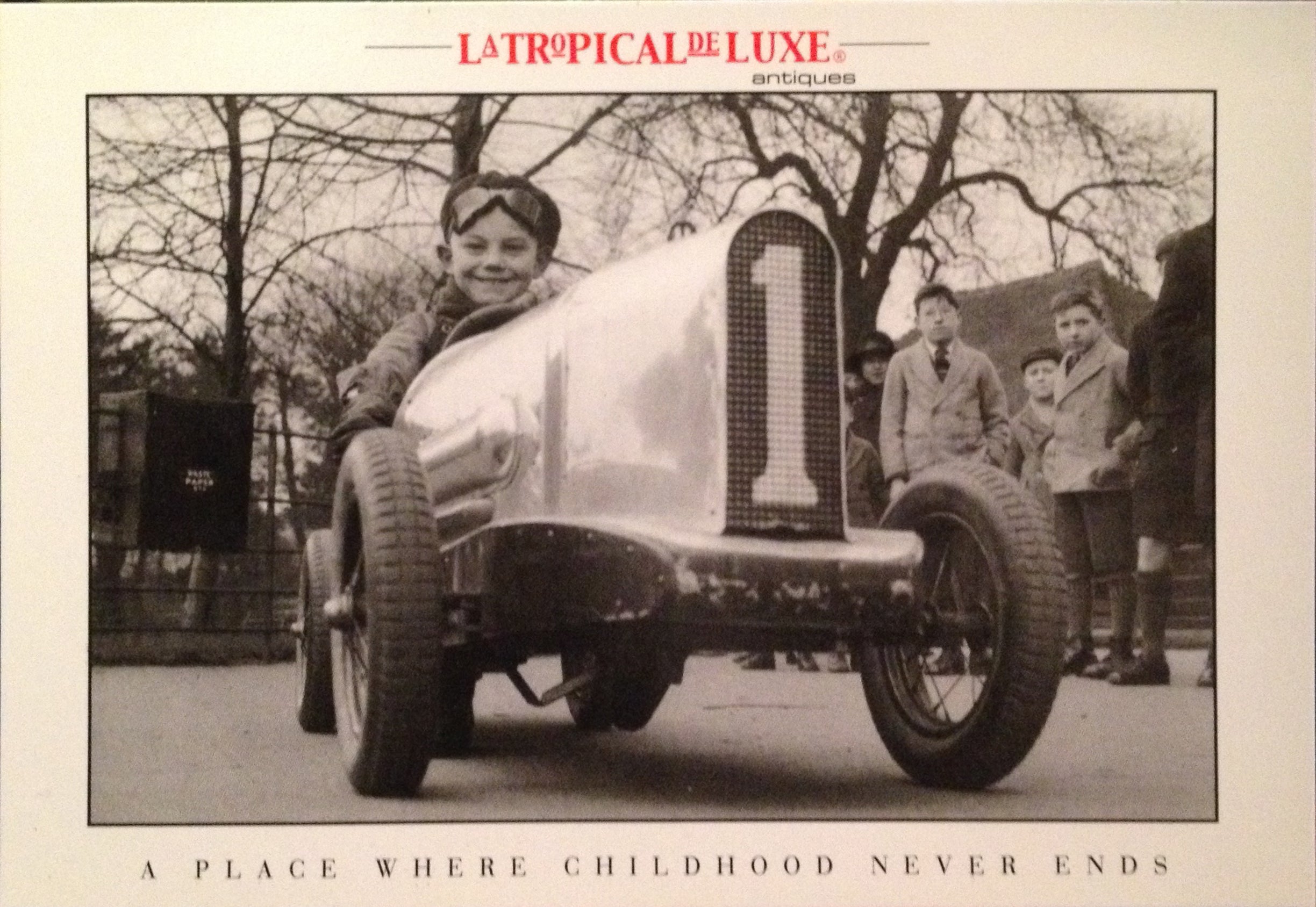
About the Seller
4.9
Vetted Professional Seller
Every seller passes strict standards for authenticity and reliability
Established in 2002
1stDibs seller since 2016
320 sales on 1stDibs
Typical response time: 1 hour
- ShippingRetrieving quote...Shipping from: Buenos Aires, Argentina
- Return Policy
Authenticity Guarantee
In the unlikely event there’s an issue with an item’s authenticity, contact us within 1 year for a full refund. DetailsMoney-Back Guarantee
If your item is not as described, is damaged in transit, or does not arrive, contact us within 7 days for a full refund. Details24-Hour Cancellation
You have a 24-hour grace period in which to reconsider your purchase, with no questions asked.Vetted Professional Sellers
Our world-class sellers must adhere to strict standards for service and quality, maintaining the integrity of our listings.Price-Match Guarantee
If you find that a seller listed the same item for a lower price elsewhere, we’ll match it.Trusted Global Delivery
Our best-in-class carrier network provides specialized shipping options worldwide, including custom delivery.More From This Seller
View AllBeer Stein / Mug Pub Sign. Mid Century Wall Hanging Folk Art Sign. 1940´s
Located in Buenos Aires, Olivos
Beer Stein / Mug Pub Sign. Mid Century Wall Hanging Folk Art Sign. 1940´s. Bar Collectible.
Perfect gift for any Beer fan. Perfect for ...
Category
Mid-20th Century American Mid-Century Modern Decorative Art
Materials
Wood
18th Century Carved Wooden Representing Christ on the Cross Folk Art
Located in Buenos Aires, Olivos
Latin American 1700s wooden crucifix. Carved face and body features. Beautiful patina. Jesus on the Cross Folk Art.
We have specialized in the sale of Art Deco and Art Nouveau and V...
Category
Antique Mid-18th Century Paraguayan Folk Art Wall-mounted Sculptures
Materials
Wood
1930's American Folk Art Wooden Bulldog Sculpture
Located in Buenos Aires, Olivos
1930's American Folk Art Wooden Bulldog Sculpture.
This is a wonderful Primitive Folk Art bull bog. A close look at the simplicity of design and constru...
Category
Mid-20th Century American Mid-Century Modern Animal Sculptures
Materials
Wood
1940´s Donald Duck Hand Carved Wooden Sign
By Walt Disney Productions
Located in Buenos Aires, Olivos
Fantastic Mid-Century Donald Duck Advertising Sign.
1940´s Hand Carved Advertising Element. Maybe made for a Cinema or for a book presentation.
Over the course of nearly eight dec...
Category
Mid-20th Century American Mid-Century Modern Toys and Dolls
Materials
Wood
Jack Daniels Old Number 7 Whiskey Tin Advertising Bar Sign / 1950s Midcentury
By Jack Daniels
Located in Buenos Aires, Olivos
Jack Daniels old number 7 whiskey tin advertising bar sign / 1950s midcentury.
Perfect to decorate a Man Cave Bar.
We have specialized in the sale of Art...
Category
Mid-20th Century American Mid-Century Modern Barware
Materials
Tin
Early 20th Century Wooden Prosthetic Articulated Arm and Hand
Located in Buenos Aires, Olivos
This is a very early and prosthetic arm. Looks like it has been made in England, but i´m not sure.
The wooden carved hand is jointed, realistic and ve...
Category
Early 20th Century English Art Nouveau Scientific Instruments
Materials
Bronze, Iron
You May Also Like
Double Sided Reverse Painted Cigar Hanging Advertising Sign
Located in London, GB
Early 20th double sided cigar sign from Belgium.
In the original casing.
Made by "La marmographie St Amf, Bruxelles" which was established circa 1910.
An advertising sign fo...
Category
Vintage 1920s Belgian Tobacco Accessories
Materials
Metal
Samuel Robb Carved Tobacciana Trade Sign
Located in Coeur d'Alene, ID
Tobacciana trade sign carved by Samuel Robb, New York, Circa 1885. Figure holds a knife and bundle of cigars with tobacco boxes. Retains original base. Total height from floor is 74"...
Category
Antique Late 19th Century American Native American Objects
Materials
Wood
Antique Pre-Neon "Choice Cigars" French Art Deco Bronze & Glass Sign - C. 1915
Located in Atlanta, GA
French, Circa 1915.
An absolutely exceptional Art Deco trade sign with original milk glass insert. The piece reads "Cigares de Choix" in French, which translates to Choice Cigars or...
Category
Early 20th Century French Art Deco Decorative Art
Materials
Bronze
$5,516 Sale Price
20% Off
Monumental 1930s Wood No Smoking Sign from New York City
Located in Los Angeles, CA
Monumental hand carved wood sign from the 1930s. Made by H.H. Upham & Co. Interestingly, this company owned a huge sign manufacturing business in the ...
Category
Vintage 1930s American Signs
Materials
Wood
Giant Wood Early 20th Century Hand Painted Americana Barber Shop Sign
Located in Santa Monica, CA
Large and chunky Americana! Fantastic and original Barber Shop trade sign in the shape of a barber pole. Great statement piece. Layers of super graphic red and white original paint. ...
Category
Early 20th Century American Folk Art Signs
Materials
Wood
Large Mid-Century Gran Habano Rajah Cigar Advertising Tobacco Store Display Sign
Located in Hamilton, Ontario
This very large and colorful placard sized store display sign was presumed to have been made in the United States for the Gran Habano Cigar Company of Honduras in the 1960s to advert...
Category
Mid-20th Century American Anglo Raj Historical Memorabilia
Materials
Paper
More Ways To Browse
Vintage Italian Sign
Signed Architect
Antique Glass Signs
Antique Folk Art Furniture
Store Signs
Antique Italian Signs
Antique Wood Signs
Vintage Antique Signs
Antique Hand Painted Signs
Vintage Open Sign
Antique Shop Sign Signs
Marcel Duchamp Signed
Antique Street Signs
Carved Wood Folk Art
Antique Sign Collectibles
Art Concrete Construction
Italian Food Art
Corbusier Signed
